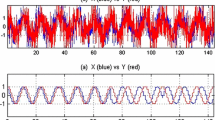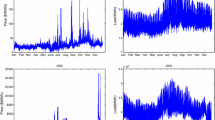Abstract
We used the detrended cross-correlation analysis (DCCA) method based on ensemble empirical mode decomposition (EEMD) to study the dynamic interdependence structure of daily domestic currency to US dollar exchange rates of 15 Southern African Development Community (SADC) exchange rate markets. We first decompose all series into intrinsic mode functions using EEMD and reconstruct the series into three frequency modes: high-, medium- and low frequency, and residue. The DCCA method was used to analyze the cross-correlation between the various frequencies, residues and original series. These were meant to address the nonlinearity and nonstationarity in observed exchange rate data. Finally, we formed a correlation network from the cross-correlation coefficients in all cases which revealed rich than would have been obtained from the original series. We observed similarities between the nature of cross-correlation between high-frequency series mimic the original series and the significant cross-correlation among the long-term trend of most SADC countries exchange rate markets. The innovation of this paper is to combine EEMD with DCCA to study the multifrequency cross-correlations of exchange rate markets, which can provide policymakers a deeper understanding of the dynamics of exchange rate markets toward the formation of currency unions.



Similar content being viewed by others
Notes
The IMFs of the remaining countries are available upon request to save space. In all, they look similar.
References
Abdalla SZS (2012) Modelling exchange rate volatility using GARCH models: empirical evidence from Arab countries. Int J Econ Financ 4:216
Adam AM, Agyapong D, Gyamfi EN (2010) Dynamic Macroeconomic convergence in the West Africa Monetary Zone (WAMZ). Int Business Manag 1:31–40. https://doi.org/10.3968/j.ibm.1923842820100101.006
Adam AM, Kyei K, Moyo S, Gill R, Gyamfi EN (2021) Similarities in Southern African Development Community (SADC) exchange rate markets structure: evidence from the ensemble empirical mode decomposition. J Afr Bus. https://doi.org/10.1080/15228916.2021.1874795
Agdeyegbe TD (2009) On the feasibility of a monetary union in the Southern Africa development community. Int J Financ Econ 13(2):150–157. https://doi.org/10.1002/ijfe.323
Alagidede P, Tweneboah G, Adam AM (2008) Nominal exchange rates and price convergence in the West African Monetary Zone. Int J Bus Econ 7(3):181–191
Asongu SA, Nwachukwu JC, Tchamyou VS (2015) A Literature Survey on Proposed African Monetary Unions, AGDI Working Paper, No. WP/15/042, African Governance and Development Institute (AGDI), Yaoundé
Baig MT (2001) Characterizing exchange rate regimes in post-crisis East Asia. International Monetary Fund. Retrieved from https://books.google.com/books?hl=en&lr=&id=Iohyl0oabrsC&oi=fnd&pg=PP2&dq=exchange+rate+comovement+in+middle+east&ots=hDYYF5DyY&sig=iMGqiQPWhaV07PZMCwW9jm7Wfw4. Accessed 10 Dec 2019
Bailliu J, King MR (2005) What Drives Movements in Exchange Rates? Bank of Canada Review Autumn, Ottawa: Bank of Canada.
Baxter M, Stockman AC (1989) Business cycles and exchange-rate regime: Some international evidence. J Monet Econ 23:377–400. https://doi.org/10.1016/0304-3932(89)90039-1
Bayoumi T (1994) A formal model of optimum currency areas. IMF Staff Pap 41:537–558. https://doi.org/10.2307/3867519
Bayoumi T, Eichengreen B (1994) One Money or Many? Analyzing the prospects for monetary unification in various parts of the world, Studies in International Finance, No. 76, Princeton, NJ: Princeton
Bildirici ME, Sonüstün B (2019) Chaos and exchange rates in economic issues: global and local perspectives, In: S. Koc, S. Y. Genc and V. F. Benli (eds), Cambridge International Academics, Cambridge, pp 70–76
Cappiello C, Engle R, Sheppard K (2006) Asymmetric dynamics in the correlations of global equity and bond returns. J Finan Econometr 4:557–572
Cheung YW, Ng LK (1996) A causality-in-variance test and its application to financial market prices. J Econometr 72:33–48
Corrales JS, Imam PA, Yehoue E WS (2016) Dollarisation in Sub-Saharan Africa. J Afr Econ 25(1):28–54. https://doi.org/10.1093/jae/ejv020
Coulibaly I, Gnimassoun B (2013) Optimality of a monetary union: New evidence from exchange rate misalignments in West Africa. Econ Model 32:463–482. https://doi.org/10.1016/j.econmod.2013.02.038
De Grauwe P (2001) The Political Economy of Monetary Union. Elgar Reference Collection. International Library of Critical Writings in Economics, vol. 134. Cheltenham, U.K. and Northampton, Mass.: Elgar.
Edwards S (2006) Monetary unions, external shocks and economic performance: a latin American perspective. IEEP 3(3):225–247. https://doi.org/10.1007/s10368-006-0056-2
Engle R (2002) Dynamic conditional correlation: a simple class of multivariate generalized autoregressive conditional heteroskedasticity models. J Business Econ Statist 20:339–350
Fama E (1970) Efficient capital markets: a review of theory and empirical work. J Financ 25:383–417
Ferreira A, Moore M, Mukherjee S (2019) Expectation errors in the foreign exchange market. J Int Money Financ 95:44–51. https://doi.org/10.1016/j.jimonfin.2019.03.005
Flandrin P, Rilling G, Goncalves P (2004) Empirical mode decomposition as a filter bank. Signal Process Lett IEEE 11(2):112–114. https://doi.org/10.1109/LSP.2003.821662
Fritz B, Mühlich L (2010) South-south monetary integration: the case for a research framework beyond the theory of optimum currency areas. Int J Public Policy 6:118–135
Ghosh AR Gulde-Wolf AM Wolf HC (2002) Exchange rate regimes: choices and consequences (vol. 1). MIT press. Retrieved from https://books.google.com/books?hl=en&lr=&id=lnDFKt0S48UC&oi=fnd&pg=PA1&dq=exchange+rate+movement+in+europe&ots=B9PmCIAec4&sig=Dv_tIODqPZ1ese1O3E7dc7vKRLM. Accessed 10 Dec 2019
Hitaj E Kolerus C Shapiro D Zdiziencka A (2013) Responding to shocks and maintaining stability in the west african economic and monetary union. African Departmental Paper, (13/07)
Honohan P, Lane, PR (2000) Will the Euro Trigger More Monetary Unions in Africa?, World Bank Country Economics Paper No. 2393
Horvatic D, Stanley HE, Podobnik B (2011) Detrended cross-correlation analysis for non-stationary time series with periodic trends. EPL Eur Lett 94:18007. https://doi.org/10.1209/0295-5075/94/18007
Hsing Y (2007) The roles of the exchange rate and the foreign interest rate in Estonia’s money demand function and policy implications. Appl Financ Econ Lett 3:221–224. https://doi.org/10.1080/17446540600706916
Huang NE, Shen Z, Long SR, Wu MC, Shih HH, Zheng Q, Yen N-C, Tung CC, Liu HH (1998) The empirical mode decomposition and the Hilbert spectrum for non-linear and non-stationary time series analysis. Proc R Soc London Ser A Math Phys Eng Sci 454:903–995. https://doi.org/10.1098/rspa.1998.0193
Ibhagui O (2017) Linking fiscal policy and external competitiveness in Sub-Saharan Africa—does government spending drive the real exchange rate in Sub-Saharan Africa, MPRA Paper 77291, University Library of Munich
Inci AC, Lu B (2004) Exchange rates and interest rates: can term structure models explain currency movements? J Econ Dyn Control 28:1595−624
Jefferis KR (2007) The Process of Monetary Integration in the SADC Region. J South Afr Stud 33(1):83–106. https://doi.org/10.1080/03057070601136590
Kenen PB (1969) The theory of optimum currency areas: an eclectic view. In: Mundell R, Swoboda A (eds) Monetary problems of the international economy. University of Chicago Press, Chicago
Khamfula Y, Huizinga H (2004) The Southern African development community: suitable for a monetary union? J Dev Econ 73(2):699–714. https://doi.org/10.1016/j.jdeveco.2003.06.003
Kim N-S, Chung K, Ahn S, Yu JW, Choi K (2014) Denoising traffic collision data using ensemble empirical mode decomposition (EEMD) and its application for constructing continuous risk profile (CRP). Accid Anal Prev 71:29–37. https://doi.org/10.1016/j.aap.2014.05.007
Kreinin ME, Plummer MG (2002) Economic integration and development: has regionalism delivered for developing countries? Edward Elgar, London
Kumo WL (2011) Working Paper 130-Growth and Macroeconomic Convergence in Southern Africa. African Development Bank
Lin CH (2012) The comovement between exchange rates and stock prices in the Asian emerging markets. Int Rev Econ Financ 22:161–172. https://doi.org/10.1016/j.iref.2011.09.006
Luukko PJJ, Helske J, Räsänen E (2016) Introducing libeemd: a program package for performing the ensemble empirical mode decomposition. Comput Statist 31:545557. https://doi.org/10.1007/s00180-015-0603-9
Mai Y, Chen H, Zou JZ, Li SP (2018) Currency co-movement and network correlation structure of foreign Exchange market. Phys A 42:65–74. https://doi.org/10.1016/j.physa.2017.09.068
McKinnon RI (1963) Optimum currency areas. Am Econ Rev 53:717–725
Meng X, Huang C-H (2019) The time-frequency co-movement of Asian effective exchange rates: a wavelet approach with daily Data. North Am J Econ Finan 48:131–148. https://doi.org/10.1016/j.najef.2019.01.009
Mpofu T (2016) The Determinants of Exchange Rate Volatility in South Africa, Economic Research Southern Africa (ERSA) Working Paper, 604
Müller UA, Dacorogna MM, Dave RD, Pictet OV, Olsen RB and Ward JR (1993) Fractals and intrinsic time: a challenge to econometricians. Unpublished manuscript, Olsen & Associates, Zurich
Mundell RA (1961) A theory of optimum currency areas. Am Econ Rev 51:509–517
Nakajima T, Hamori S (2012) Causality-in-mean and causality-in-variance among electricity prices, crude oil prices, and yen-us dollar exchange rates in Japan. Res Int Bus Financ 26(4):371–386
Nzimande NP Ngalawa H (2016) Is there a SADC business cycle? Evidence from a dynamic factor model (No. 651). Cape Town: Economic Research of Southern Africa.
Orlov AG (2009) A Spectral analysis of exchange rate comovements during Asian financial crisis. J Int Finan Markets Inst Money 19:742–758. https://doi.org/10.1016/j.intfin.2008.12.004
Owusu Junior P, Adam AM, Tweneboah G (2017) Co-movement of real exchange rates in the West African Monetary Zone. Cogent Econ Financ 5(1):1351807. https://doi.org/10.1080/23322039.2017.1351807
Pereira EJAL, Ferreira PJS, da Silva MF, Miranda JGV and Pereira HBB (2019) Multiscale network for 20 stock markets using DCCA. P hysica A 529:121542
Piao L, Fu Z (2016) Quantifying distinct associations on different temporal scales: comparison of DCCA and Pearson methods. Sci Rep 6:36759. https://doi.org/10.1038/srep36759
Podobnik B, Stanley HE (2008) Detrended cross-correlation analysis: a new method for analyzing two nonstationary time series. Phys Rev Lett 100:084102
Prass TS, Pumi G (2021) On the behavior of the DFA and DCCA in trend-stationary processes. J Multivar Anal 182(2021):104743
Reboredo JC, Rivera-Castro MA (2013) A wavelet decomposition approach to crude oil price and exchange rate dependence. Econ Model 32:42–57. https://doi.org/10.1016/j.econmod.2012.12.028
Redda EH and Muzindusti PF (2017) Does SADC constitute an optimum currency area? Evidence from generalised purchasing power parity. In Proceedings of economics and finance conferences (No. 4807771). International Institute of Social and Economic Sciences, London
Rose AK (2008) EMU, Trade and Business Cycle Synchronization. University of California, Berkeley working paper, mimeo
Schiller RJ (2000) Irrational exuberance. Princeton University Press, Princeton
Shin K-H, Lim G, Min S (2020) Dynamics of the global stock market networks generated by DCCA methodology. Appl Sci 10(6):2171. https://doi.org/10.3390/app10062171
Stošić D, Stošić D, Stošić T, Stanley HE (2015) Multifractal properties of price change and volume change of stock market indices. Phys A 428:13–18. https://doi.org/10.1016/j.physa.2015.02.046
Tamakoshi G, Hamori S (2013) An asymmetric dynamic conditional correlation analysis of linkages of European financial institutions during the Greek sovereign debt crisis. Eur J Financ 19(10):939–950
Tavlas GS (1993) The ‘New’ theory of optimum currency areas. World Econ 16:663–685. https://doi.org/10.1111/j.1467-9701.1993.tb00189.x
Tipoy CK (2015) Real convergence using TAR panel unit root tests: an application to Southern African Development Community (No. 536). Economic Research of Southern Africa.
Toyoshima y, Tamakoshi G and Hamori S, (2012) Asymmetric dynamics in correlations of treasury and swap markets: Evidence from the US market. J Int Finan Markets Inst Money 22(2):381–394
Wang J-Y, Masha I, Shirono K and Harris L (2007) The common monetary area in southern africa: shocks, adjustment, and policy challenges. IMF Working Paper 07/158. Washington, DC: International Monetary Fund
Wu Z, Huang NE (2009) Ensemble empirical mode decomposition: a noise-assisted data analysis method. Adv Adapt Data Anal 1:1–41. https://doi.org/10.1142/S1793536909000047
Xu M, Shang P, Lin A (2016) Cross-correlation analysis of stock markets using EMD and EEMD. Phys A Stat Mech Appl 442:82–90. https://doi.org/10.1016/j.physa.2015.08.063
Zebende GF (2011) DCCA cross-correlation coefficients: quantifying level of crosscorrelation. Physica A 390:614–618
Zehirun MF, Breitenbach MC, Kemegue F (2015) Assessment of Monetary Union in SADC: Evidence from Cointegration and Panel Unit Root Tests, Economic Research Southern Africa (ERSA) Paper No. 945.
Zehirun MF, Breitenbach MC, Kemegue F (2016) Exploring exchange rate-based policy coordination in SADC. Stud Econ Financ 33(4):576–594. https://doi.org/10.1108/SEF-03-2015-0089
Zerihun MF, Breitenbach MC, Kemegue F (2014) Greek wedding in SADC? Testing for structural symmetry toward SADC monetary integration. Afr Financ J 16(2):16–33
Zhang X, Lai KK, Wang SY (2008) A new approach for crude oil price analysis based on empirical mode decomposition. Energy Econ 30(3):905–918. https://doi.org/10.1016/j.eneco.2007.02.012
Zhou S (2002) The forward premium anomaly and the trend behavior of the exchange rates. Econ Lett 76(2):273–279. https://doi.org/10.1016/s0165-1765(02)00053-8
Author information
Authors and Affiliations
Corresponding author
Additional information
Publisher’s note
Springer Nature remains neutral with regard to jurisdictional claims in published maps and institutional affiliations.
Rights and permissions
About this article
Cite this article
Adam, A.M., Kyei, K., Moyo, S. et al. Multifrequency network for SADC exchange rate markets using EEMD-based DCCA. J Econ Finan 46, 145–166 (2022). https://doi.org/10.1007/s12197-021-09560-w
Accepted:
Published:
Issue Date:
DOI: https://doi.org/10.1007/s12197-021-09560-w
Keywords
- Detrended cross-correlation analysis (DCCA)
- Ensemble empirical mode decomposition (EEMD)
- Intrinsic mode function
- Exchange rate
- Short data span
- Nonstationarity
- Nonlinearity
- Long memory
- Time series




